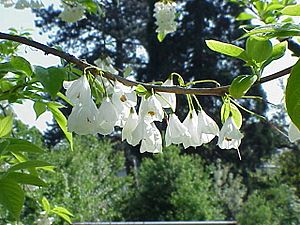Carolina silverbells facts for kids
Quick facts for kids Little silverbell |
|
|---|---|
 |
|
| Conservation status | |
| Scientific classification | |
| Genus: |
Halesia
|
| Species: |
carolina
|
| Synonyms | |
|
|
The Halesia carolina, often called the Carolina silverbell or little silverbell, is a beautiful species of flowering plant. It belongs to the family called Styracaceae. This plant naturally grows in the southeastern United States.
Contents
What is the Carolina Silverbell?
The Carolina silverbell is a strong, fast-growing plant. It can be a deciduous shrub or a small tree. It can grow up to 8 m (26 ft) tall and 10 m (33 ft) wide.
Its Unique Features
In the spring, before its leaves fully appear, this plant shows off many bell-shaped white flowers. These flowers hang down like tiny bells. After the flowers, you will see green fruits that have four wings. In the autumn, the leaves of the Carolina silverbell turn a bright yellow color.
Where Does the Silverbell Grow?
The Carolina silverbell does not grow in many places. Its main home is in the panhandle area of Florida. You can also find smaller groups of these plants in South Carolina, Georgia, Alabama, and Mississippi.
Famous Silverbell Trees
One very special Carolina silverbell tree is listed on the 2015 American Forests Champion Trees national register. This "champion" tree is quite far from where these plants usually grow. It is located in Roxbury, New Hampshire.
Understanding the Silverbell's Name
Scientists sometimes find it tricky to name plants correctly. For the four-winged American silverbells, there has been some confusion. Several names have been used, like H. carolina, H. parviflora, H. monticola, and H. tetraptera.
Why is it Called H. carolina?
The plant we are talking about here has also been called H. parviflora. However, many plant scientists now use the name H. carolina. This is because H. carolina was named first by L., a famous scientist. Even though there was some debate, H. carolina is the name used today.
Growing Carolina Silverbells
People often grow the Carolina silverbell in gardens. In the United Kingdom, a special type called H. carolina Vestita Group has won an important prize. It received the Royal Horticultural Society's Award of Garden Merit. This award means it is an excellent plant for gardens.
Best Conditions for Growing
If you want to grow a Carolina silverbell, it needs certain conditions. It prefers soil that is either acid or neutral. It also likes a spot that is partly shaded, not in full sun all day.
See also
 In Spanish: Halesia carolina para niños
In Spanish: Halesia carolina para niños


